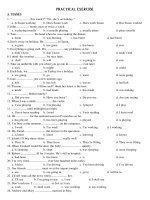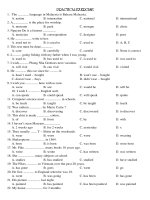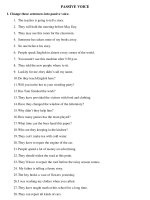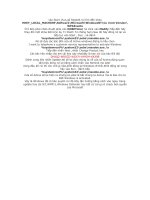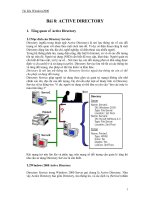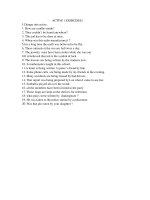- Trang chủ >>
- Đại cương >>
- Toán cao cấp
Active Maths Practical Ideas Choose
Bạn đang xem bản rút gọn của tài liệu. Xem và tải ngay bản đầy đủ của tài liệu tại đây (176.34 KB, 2 trang )
Active Maths Practical Ideas
Choose a form of exercise e.g. star jumps.
Assign an exercise to the numbers 2, 5 and 10
Reception children could roll a dice, count the
amount of dots and then do that amount of star
Start by counting in ones to 20. Whenever
you say a number that is in the 2 times table
jumps.
complete the exercise you have chosen for 2.
Year 1 and 2 childern could roll two dice, add
them together and then do that amount of star
Now count in ones to 20 but each time you say
a number in the 5 times table, complete the
jumps.
exercise you have chosen for 5.
Year 3 and 4 could roll two dice, add them
Repeat for the 10 times table.
together and then multiply by 3 and then do
that amount of star jumps.
Year 5 and 6 could roll two dice, multiply them
together and then divide by 4. Using the whole
number in the answer, complete that many star
jumps.
Can you join them all together? Count in ones
to 20 but perform all three exercises. How
many exercises will you need to do when you
say 10? Good luck!
Can you make up your own rules?
Post videos on our Facebook page
Set up a Sports day in your back garden.
Suggested activities
•
Throwing bean bags into hoops at different distances (measured by the children if possible).
Score points for how many bean bags you get into the hoops. The hoop furthest away will
have the highest score. What is the total score?
•
Running between two different points, skipping between two different points. Score a point
(or a multiple you are struggling with) each time you run between the points. What is your
total score? If each run is worth 3 and you run between the points 7 times, your score will
•
be 7 x 3 = 21.
In a minute, how many times can you skip with a rope. Score 2 points per skip.
What other activities could you include in your sports day? What will the scoring system be?
Put numbers 1-10 on card/post it on your fence/ garage. Call out
a calculation e.g. 10-5 = . Children run up from a starting point to
the correct answer and tap it. How many can they answer in a
minute? Make it competitive and play against a partner. If it is
a warm day, throw a sponge and see if you can hit the answer!
For older children put the products from times tables they are
struggling with on the card. Call out a times table fact e.g. 6 x 7
On 12 separate pieces of paper, write the multiples of a times table you are learning. E.g. 3
times table.
Get a member of you family to do the same but with a different times table.
Scrunch the pieces of paper into 12 balls each.
Draw a line with chalk between you to represent a net in tennis.
At the same time throw your balls onto your opponent’s side of the net. Continue to throw the
balls across the net for 2 minutes. The aim is to have all your times table balls on your
opponent’s side after two minutes so if they throw it back onto your side, you need to check
the multiple and throw it back quick if it is one of yours! After two minutes are up, check the
balls on your side and get a point for each multiple that is your timetables. The person with
the smallest score is the winner!
Using chalk, draw the numbers 1-10 in circles on the
ground.
Roll one or two dice and add them together. Now jump on
as many circles as you need to make the total on the dice
by adding the numbers together as you go.
How many ways can you do it?
Instead of adding the dice together, make a two-digit
number and then jump on as many circles so when the
numbers are added together, they make the two-digit
number.
